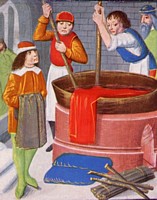 |
| The process of dying added amazing pops of color to wool. |
The art of wool weaving created a demand for this specific
commodity specifically clothing. Wool became a style and a want of many English
during the medieval time period. Fashion and a certain look became a desire and
thus the birth of wool trend. The way wool was gathered, created, and sold wasa diligent process. England terrain and climate was perfect for rearing sheep.When sheep are first sheered the wool is raw and dirty. From England it would
be sent to France where they process and clean the wool. The French had
expertise in purifying, bleaching, and dying fabric. Later the English gained
more knowledge and they no longer needed to export wool for cleaning and
coloring. Many people had to take part in combing the wool after it returned
from France. Mainly housewives would comb the wool through and through and this
also helped clean it. English also learned from the French how to weave the
wool into cloth. Using tools like the spinning wheel that wove the wool intofabric that could be used to make different types of garments and yarns. The most
efficient spinning wheels were closest to running waterways that would power
the wheel to make it fast moving. This is clear use of hydropower that the
medieval English used to their advantage. After the fabric was woven it could
be dyed further. Colors started as basic in the early medieval era, but over
time they learned more tricks and vibrant colors. They used certain plants,
flowers, insects, and fruits to create dyes. Red was the hardest dye to obtain
therefore making it the most desirable color of wool. Blue was in abundance and
more common. Some times patterns or multiple colors could be incorporated to
create a design for richer folk. Colorful fashion became a popular trend to
those who could afford it.
The specific type of textile and garments wore would signifywhich social class an individual belonged to in Medieval England. In that way
fashion is similar to today how we can tell who is wealthy by the quality of
what they’re wearing and how they look. Oppositely in the medieval era social
classes specifically lower classes were restricted by Lords in which textiles
they could don and how much they could spend on apparel. Craftsmen were not
permitted to buy any clothing that was more than 4 shillings in price. Also
they were not allowed to wear silk and cloth that was silver or gold colored. Wool
made a large impact on society as a whole. It took part in the manufacturing and trade sector of
medieval England. It created jobs, fashion, trade, art and more. Everyone could
wear wool no matter the class. It was all in how they wore it and created their
own sense of style.
I can't believe the English exported the wool, that must have ben expensive. I like how they used hydropower to power the weaving process. How very smart! I guess we see them usually as unintelligent and basic, thank you for reminding us otherwise. Great post, I enjoyed it a lot.
ReplyDeleteI really found tis article to really informational especially because I had no idea Wool was such a huge part of their lives. I also agree with Allison when she talked about exporting the Wool for other countries to enjoy.
ReplyDeleteIt is also very interesting that the color of the garment could signify how wealthy you are. It was also illegal for poor individuals to wear certain colors such as gold and silver.
DeleteI really found tis article to really informational especially because I had no idea Wool was such a huge part of their lives. I also agree with Allison when she talked about exporting the Wool for other countries to enjoy.
ReplyDeleteThis was a great post to read. I didn't know how important the commodity of wool was to the social and economic structure of medieval England. It is also interesting to see how the wool was traded internationally and used to make various goods. I also didn't know that dyes were used during this time period.
ReplyDelete